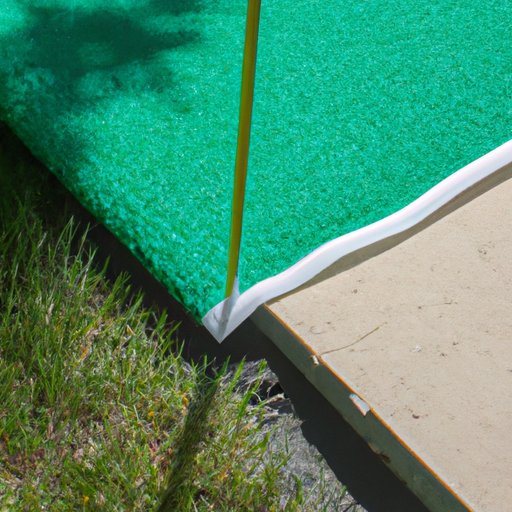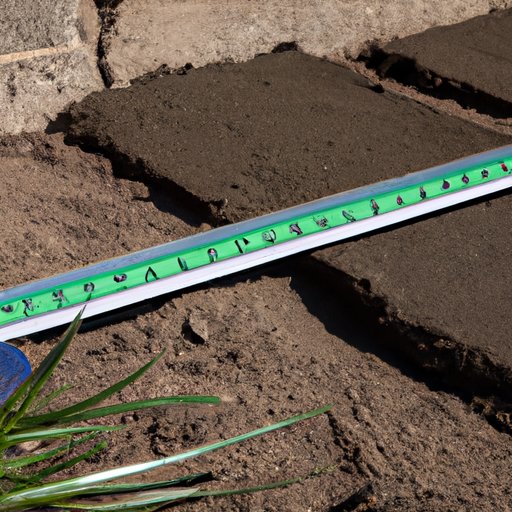
How to Level Ground for Your Pool: A Step-by-Step Guide
Installing a pool in your yard can be an exciting project, but it comes with its own set of challenges. One of the most common problems that homeowners encounter is uneven ground, which can cause damage to the pool frame and liner. Properly leveling the ground is essential for ensuring you have a sturdy and safe pool installation. In this guide, we’ll explore the basic steps for leveling ground for your pool.

Basic Steps for Leveling Ground for a Pool
Before beginning the process, you’ll need to gather the necessary tools, including a level, transit or laser level, a shovel, and a wheelbarrow. With these tools in hand, follow these steps for leveling the ground for your pool:
Surveying the Site
The first step in leveling the ground is surveying the site. This involves identifying the high and low spots in the area where you plan to install your pool. Use a level or transit to map out the area, taking note of any significant variations in the slope or grade.
Removing Obstacles
Once you’ve surveyed the area, clear any debris, rocks, or other obstacles that could interfere with the leveling process. This includes removing any vegetation, as well as any underground pipes or cables.
Adding Fill Dirt or Gravel
Next, you’ll need to add fill dirt or gravel to create a level surface. This will help raise the low spots and provide a base for the pool. Make sure the fill is spread out evenly, and use a shovel to compact the dirt or gravel as you go.
Leveling the Soil
Finally, it’s time to level the soil. Use the level or laser level to ensure the ground is level and even. This may require adding more fill dirt in certain areas or removing excess soil in others. Take your time during this step to ensure the ground is level, stable, and ready for the pool installation.
Choosing the Right Location and Orientation
In addition to the basic steps for leveling the ground, it’s important to choose the right location and orientation for your pool. Here are some factors to consider:
How to Select the Best Location
When choosing a location for your pool, look for a spot that’s relatively flat and free of obstacles. Avoid areas with too much slope or that are close to trees or other foliage. Consider factors like privacy, sun exposure, and proximity to your home.
Importance of Proper Drainage and Access to Utilities
Make sure the area you choose has proper drainage to prevent water from accumulating around the pool. You should also have access to utilities like electricity and water for pool maintenance.
Measuring Orientation for Proper Sunlight
The orientation of your pool can impact the amount of sunlight it receives throughout the day. Measure the orientation carefully to ensure your pool gets the appropriate amount of sunlight, based on your preferences.
Tools and Tips For Ensuring Level Ground
Properly leveling the ground for your pool is essential for its long-term stability. Here are some tools and tips to help you ensure your pool is level and secure:
The Use of Levels and Transit or a Laser Level
Use a level or transit to help you identify the high and low spots in the ground, as well as to ensure your fill dirt is spread evenly. A laser level can help you achieve a perfectly flat surface.
Common Errors That Lead to Uneven Surface
Avoid mistakes like using too little or too much fill dirt or failing to compact the soil properly. These mistakes can lead to an uneven surface, which can compromise the stability of your pool.
Different Types of Pool Foundations
There are several different types of pool foundations to consider, each with its own set of pros and cons. Here are three of the most popular options:
Concrete Slabs
A concrete slab is a popular choice for above-ground pools. This type of foundation provides a sturdy, even surface that can withstand heavy use. However, it can be expensive and time-consuming to install.
Pavers
Pavers are a versatile option that can be used to create a variety of pool shapes and sizes. They’re also aesthetically pleasing and durable. However, they can be difficult to install properly and require regular maintenance to prevent shifting or settling.
The Pros and Cons of Each Foundation
When choosing the right foundation for your pool, consider factors like cost, durability, and ease of installation. Consult with a pool installation professional for guidance and recommendations.
Preparing a Stable Base for the Pool
In addition to leveling the ground, you’ll need to prepare a stable base for your pool. Here are some tips for getting started:
Compact the Soil
After adding the fill dirt, use a compactor to help stabilize the soil. This will help prevent settling or shifting over time.
The Benefits of Using Geotextile Fabric
Geotextile fabric can help provide an extra layer of protection for the pool liner. It can also help prevent soil erosion and provide added support for heavy pool equipment.
Safety Guidelines for Leveling the Ground for a Pool
As with any construction project, safety should be your top priority. Here are some guidelines to follow:
Wear Protective Gear
Wear work gloves, hard hats, and safety glasses to protect yourself while working.
Check for Utility Lines
Before beginning any digging or excavation, call your utility company to check for underground cables or pipelines.
Using a Professional Contractor if Necessary
If you’re unsure about any aspect of pool installation, or if you don’t have the necessary tools and experience, consider hiring a professional contractor. They can help ensure your pool is installed safely and correctly.
Conclusion
In summary, leveling the ground for your pool is an essential part of the installation process. By following the basic steps outlined in this guide, you can ensure a stable and safe foundation for your pool. Whether you choose a concrete slab, pavers, or another type of foundation, proper preparation is key to getting the most out of your pool for years to come.




